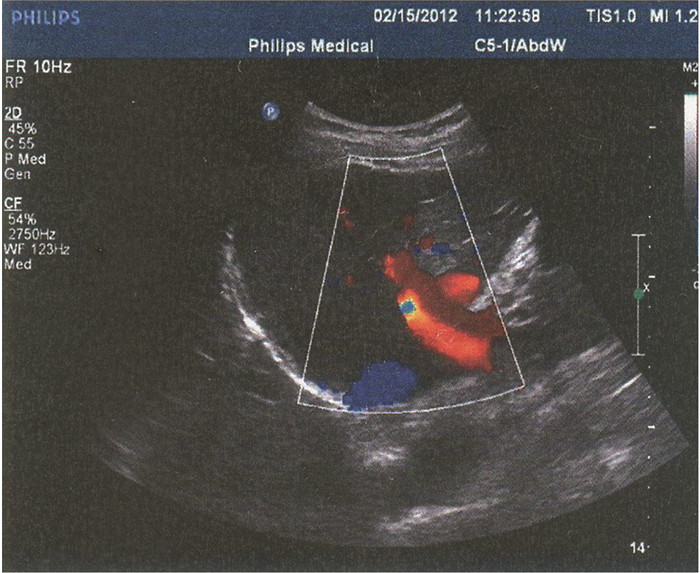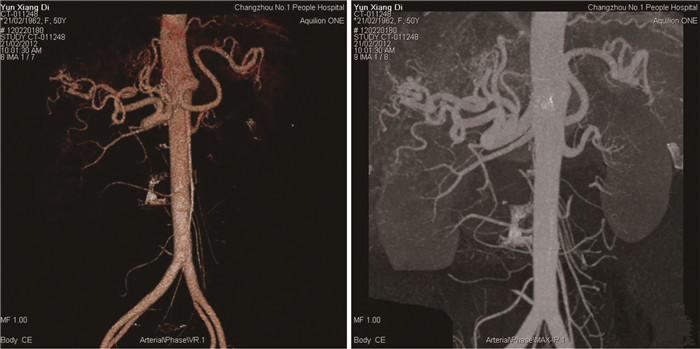肝脏遗传性出血性毛细血管扩张症1例报告
DOI: 10.3969/j.issn.1001-5256.2022.02.032
利益冲突声明:所有作者均声明不存在利益冲突。
作者贡献声明:王婷婷负责收集资料,撰写论文;马亮、陈建平负责指导修改文章并最后定稿。
-
-
关键词:
- 毛细血管扩张, 遗传性出血性 /
- 肝疾病 /
- 动静脉畸形
-
-
[1] LI J, LI T, SUN XF. Ultrasound diagnosis of heredi tary hemorrhagic telangiectasia: A case report[J]. J Clin Hepatol, 2019, 35(6): 1351-1352. DOI: 10.3969/j. issn. 1001-5256. 2019. 06. 037.李杰, 李彤, 孙晓峰. 超声诊断遗传性出血性毛细血管扩张症1例报告[J]. 临床肝胆病杂志, 2019, 35(6): 1351-1352. DOI:10.3969/j. issn. 1001-5256. 2019. 06. 037. [2] MACRI A, BERMUDEZ R. Osler-Weber-Rendu disease[M]. Treasure Island(FL): StatPearls Publishing, 2018. [3] FELLI E, ADDEO P, FAITOT F, et al. Liver transplantation for hereditary hemorrhagic telangiectasia: A systematic review[J]. HPB (Oxford), 2017, 19(7): 567-572. DOI: 10.1016/j.hpb.2017.03.005. [4] SHOVLIN CL, GUTTMACHER AE, BUSCARINI E, et al. Diagnostic criteria for hereditary hemorrhagic telangiectasia (Rendu-Osler-Weber syndrome)[J]. Am J Med Genet, 2000, 91(1): 66-67. DOI: 10.1002/(sici)1096-8628(20000306)91:1<66::aid-ajmg12>3.0.co;2-p. [5] FAUGHNAN ME, PALDA VA, GARCIA-TSAO G, et al. International guidelines for the diagnosis and management of hereditary haemorrhagic telangiectasia[J]. J Med Genet, 2011, 48(2): 73-87. DOI: 10.1136/jmg.2009.069013. [6] GARCIA-TSAO G, KORZENIK JR, YOUNG L, et al. Liver disease in patients with hereditary hemorrhagic telangiectasia[J]. N Engl J Med, 2000, 343(13): 931-936. DOI: 10.1056/NEJM200009283431305. [7] ANDREJECSK JW, HOSMAN AE, BOTELLA LM, et al. Executive summary of the 12th HHT international scientific conference[J]. Angiogenesis, 2018, 21(1): 169-181. DOI: 10.1007/s10456-017-9585-2. [8] European Association for the Study of the Liver. EASL clinical practice guidelines: Vascular diseases of the liver[J]. J Hepatol, 2016, 64(1): 179-202. DOI: 10.1016/j.jhep.2015.07.040. [9] MCALLISTER KA, GROGG KM, JOHNSON DW, et al. Endoglin, a TGF-beta binding protein of endothelial cells, is the gene for hereditary haemorrhagic telangiectasia type 1[J]. Nat Genet, 1994, 8(4): 345-351. DOI: 10.1038/ng1294-345. [10] BERG JN, GALLIONE CJ, STENZEL TT, et al. The activin receptor-like kinase 1 gene: Genomic structure and mutations in hereditary hemorrhagic telangiectasia type 2[J]. Am J Hum Genet, 1997, 61(1): 60-67. DOI: 10.1086/513903. [11] GALLIONE CJ, REPETTO GM, LEGIUS E, et al. A combined syndrome of juvenile polyposis and hereditary haemorrhagic telangiectasia associated with mutations in MADH4 (SMAD4)[J]. Lancet, 2004, 363(9412): 852-859. DOI: 10.1016/S0140-6736(04)15732-2. [12] ZHAO YL, ZHANG Y, WANG XD, et al. Applying of the curacao criteria combined with genetic testing for the diagnosis of hereditary hemorrhagic telangiectasia[J]. Chin Arch Otolaryngol Head Neck Surg, 2018, 25(9): 507-511. DOI: 10.16066/j.1672-7002.2018.09.012.赵亚丽, 张媛, 王向东, 等. 遗传性出血性毛细血管扩张症临床及基因检测综合诊断的应用[J]. 中国耳鼻咽喉头颈外科, 2018, 25(9): 507-511. DOI: 10.16066/j.1672-7002.2018.09.012. [13] ABDALLA SA, LETARTE M. Hereditary haemorrhagic telangiectasia: Current views on genetics and mechanisms of disease[J]. J Med Genet, 2006, 43(2): 97-110. DOI: 10.1136/jmg.2005.030833. [14] JIN Y, MUHL L, BURMAKIN M, et al. Endoglin prevents vascular malformation by regulating flow-induced cell migration and specification through VEGFR2 signalling[J]. Nat Cell Biol, 2017, 19(6): 639-652. DOI: 10.1038/ncb3534. [15] GUILHEM A, FARGETON AE, SIMON AC, et al. Intra-venous bevacizumab in hereditary hemorrhagic telangiectasia (HHT): A retrospective study of 46 patients[J]. PLoS One, 2017, 12(11): e0188943. DOI: 10.1371/journal.pone.0188943. [16] MITCHELL A, ADAMS LA, MACQUILLAN G, et al. Bevacizumab reverses need for liver transplantation in hereditary hemorrhagic telangiectasia[J]. Liver Transpl, 2008, 14(2): 210-213. DOI: 10.1002/lt.21417. [17] RUIZ S, CHANDAKKAR P, ZHAO H, et al. Tacrolimus rescues the signaling and gene expression signature of endothelial ALK1 loss-of-function and improves HHT vascular pathology[J]. Hum Mol Genet, 2017, 26(24): 4786-4798. DOI: 10.1093/hmg/ddx358. [18] KIM YH, KIM MJ, CHOE SW, et al. Selective effects of oral antiangiogenic tyrosine kinase inhibitors on an animal model of hereditary hemorrhagic telangiectasia[J]. J Thromb Haemost, 2017, 15(6): 1095-1102. DOI: 10.1111/jth.13683. -



 PDF下载 ( 2696 KB)
PDF下载 ( 2696 KB)


 下载:
下载:




